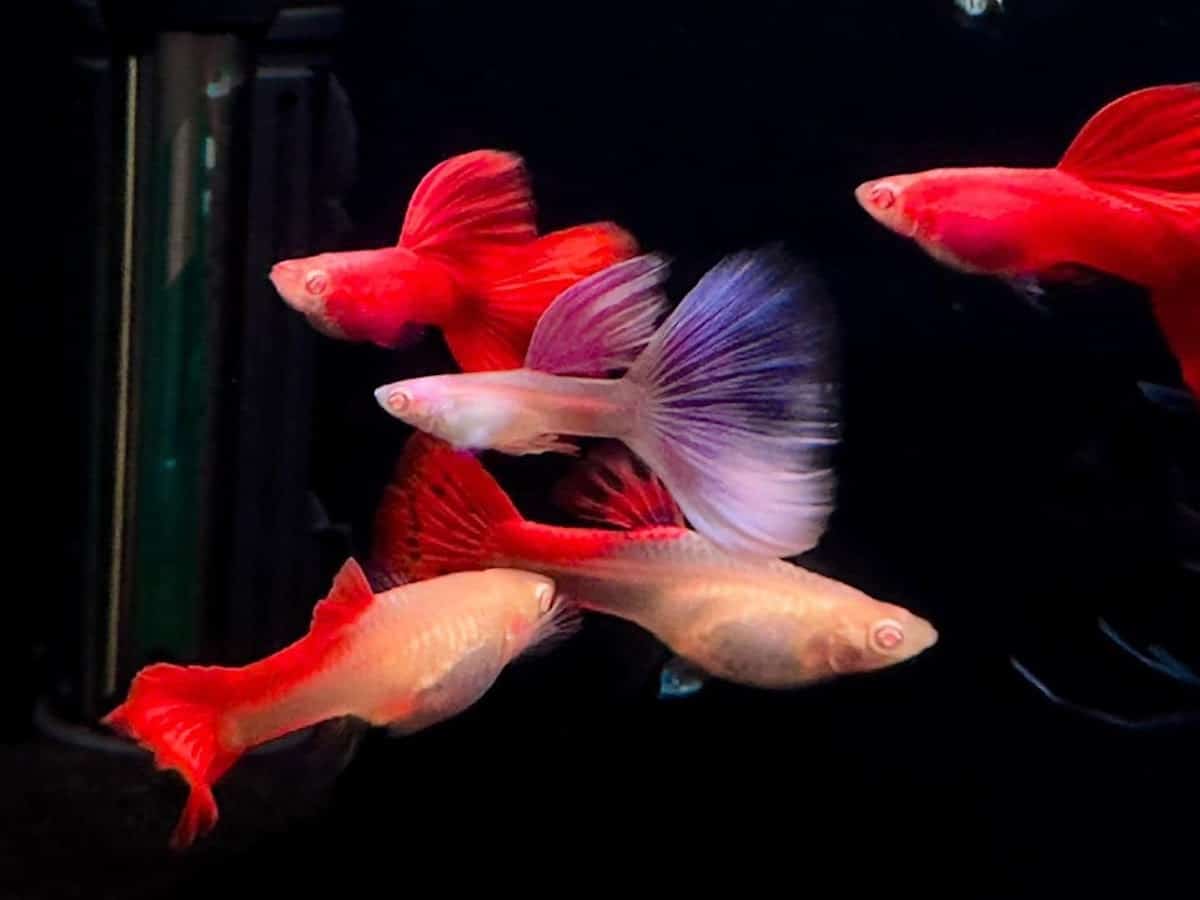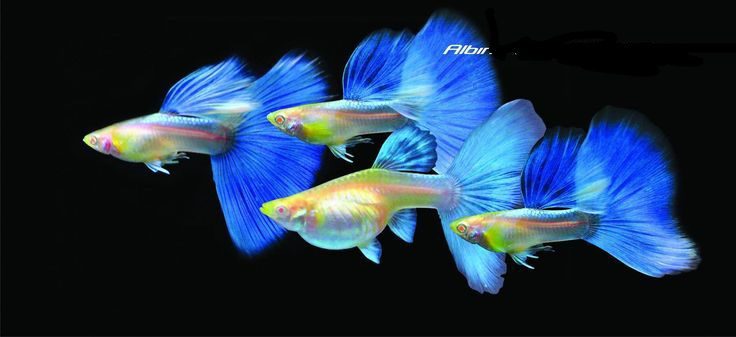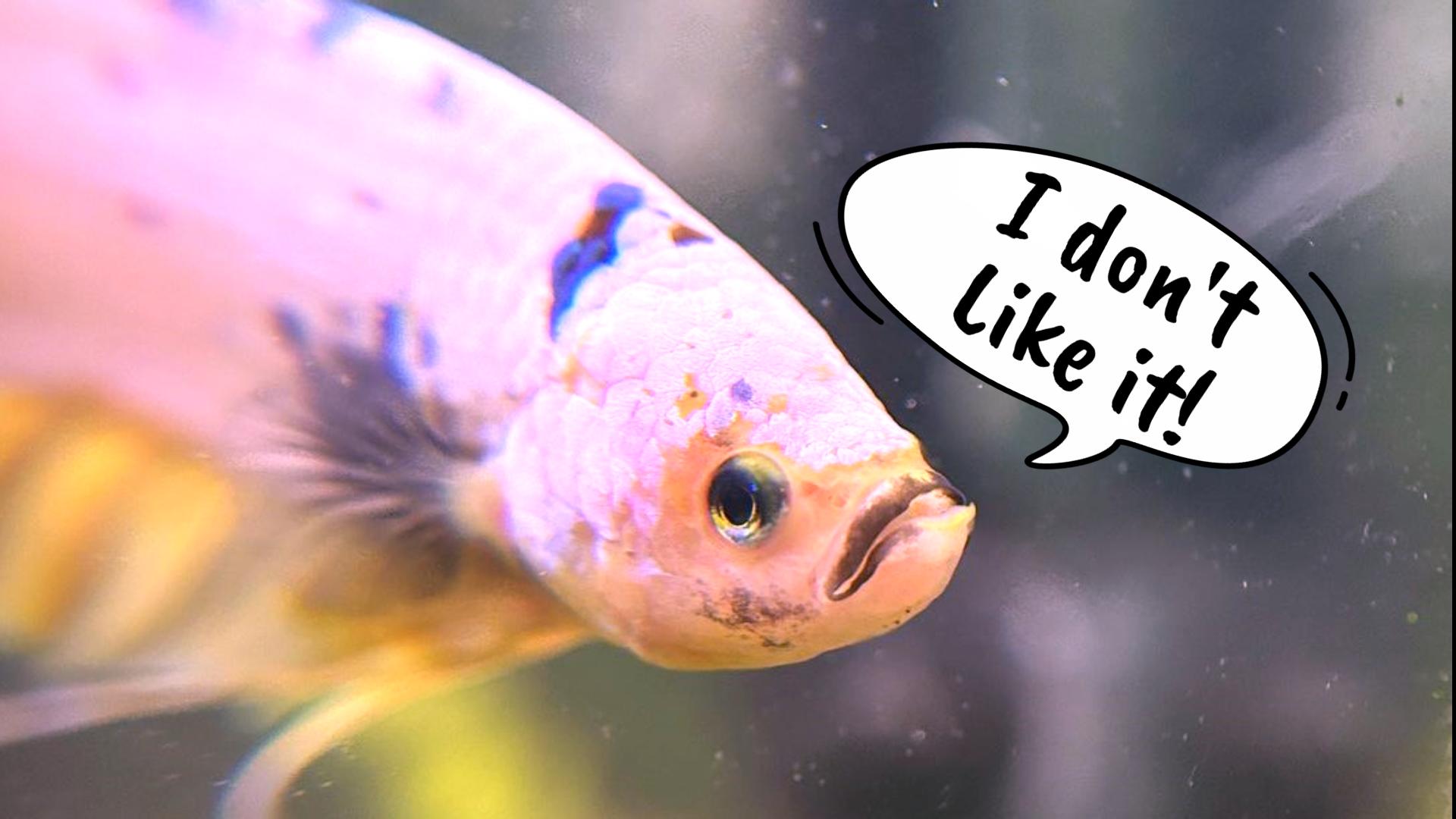Today, we’ll look at the different tail types of guppy fish. I’m excited to share in-depth details about the 15 different guppy tail types. Whether you’re a guppy enthusiast or just curious about these guppy fish, today’s blog will be a must-watch. I’m excited to hear from you in the comments about which of these guppy tail types you currently own, after reading this post. Let’s get started.
Guppies are one of the most popular and beloved fish among aquarium hobbyists, and one reason for their popularity is their diverse range of tail types. The tails of each type have their own unique features, including their shape and colors, and they can enhance your aquarium’s appearance. In this blog, we’ll discuss 15 different guppy fish tail types and what makes each special. Although many guppy varieties are named after their coloration for marketing purposes, we will focus only on tail shape types in today’s blog.
#1. Delta Tail
The Delta Tail guppy is a triangular-shaped guppy with a tail that broadens at the base and angles to a point, with a 50 to 80-degree spread from the body. Its symmetrical shape and vibrant colors make it a highly popular tail type among guppy enthusiasts and breeders. The Delta Tail’s triangular shape gives it an attractive and striking appearance in an aquarium. Its coloration can range from solid to multi-colored, depending on the strain. This tail type is also known as the triangle tail.

#2. Veil Tail

The Veil Tail guppy boasts an isosceles triangle-shaped tail with impeccably straight edges, forming a graceful 45-degree angle from top to bottom. While typically in proportion to the guppy’s body length, slight variations can occur depending on the strain. This splendid tail widens elegantly at its base, gently tapering towards its delicate tip. It often showcases a translucent quality and comes adorned in a spectrum of hues, either in a single shade or adorned with intricate patterns, harmonizing exquisitely with the guppy’s body coloration.
One distinguishing feature of the Veil Tail guppy is its remarkable flexibility. Unlike rigid tails, it moves with effortless grace, allowing the guppy to navigate with exceptional agility. This adaptability isn’t just visually appealing; it serves a functional purpose. The flexible tail enables the guppy to swim efficiently and swiftly, enhancing its ability to evade potential predators.
How is Veiltail different from Delta Tail?
Veil Tail guppy has a flowing isosceles triangle-shaped tail, while the Delta Tail guppy has a triangular-shaped tail that broadens at the base and angles to a point. This is the primary difference between these two types of tails.
#3. Double Swordtail

The Double Swordtail Guppy is characterized by its two sword-like extensions on the tail, which are longer in males than in females and can grow up to twice the length of the body. Double Swordtail Guppy has top and bottom swordtails. The Top Swordtail has extensions originating from the top of the caudal peduncle, while the Bottom Swordtail has extensions originating from the bottom of the caudal peduncle. The Double Swordtail Guppy’s tail extensions can be straight or slightly curved. They have a sharp point at the end, which adds to their distinctive appearance. These extensions are a crucial characteristic for breeders, as they play a significant role in determining the quality of the fish. The Double Swordtail Guppy’s body is generally small and streamlined, which helps it swim quickly and gracefully through the water.
#4. Halfmoon Tail – Guppy Fish
The Halfmoon Tail guppy is one of the most popular tail types among guppy enthusiasts. This tail is shaped like a half-moon and when fully spread, forms a 180-degree angle. The tail is usually symmetrical, with both lobes the same size and shape. These fish swim gracefully, especially when their tail is fully spread, and they are often observed swimming near the water surface. It’s best to keep them in a well-filtered aquarium with gentle water movement since their tails can make it difficult to swim in strong currents. Additionally, it’s important to provide plenty of hiding places and avoid keeping them with fin-nipping fish since their long fins can be easily damaged.

#6. Fan tail
As the name suggests, this guppy’s tail resembles a fan. It is a broad tail type that spreads out like a hand-held fan when the guppy swims, making it an eye-catching addition to any aquarium. The tail’s outer edges are usually rounded, while the inner edges are straight. The tail itself is relatively short, usually about the same length as the guppy’s body. Due to its unique shape and striking appearance, the Fan Tail guppy is a popular choice for both beginner and experienced guppy keepers.

#7. Crown tail

The Crowntail Guppy is characterized by its spiky and serrated edges, which give it the appearance of a crown. The tail is usually quite large and flowing, with a triangular shape that tapers to a point. The tail edges are not straight like many other guppy tail types, but instead deeply indented and jagged. Crowntail guppy attracts many Crowntail Betta fish lovers who love such tail types in their tank.
#8. Round tail

Round-tail guppies are known for their circular tail fins. The tail is wide at the base and tapers to a round tip, giving the fish a distinctive appearance. The round tail is similar to the fan tail but has a more circular shape. The tail is typically held at a 45-degree angle, common among guppy tail types. It’s also known as the ball tail. One of the unique characteristics of the round-tail guppy is that it is available in a variety of colors, including red, blue, green, yellow, and orange. This makes them a popular choice for hobbyists who want colorful and unique fish to add to their collection.
#9. Pintail

The pin tail is a tail type that is narrow and pointed, resembling a pin. The pin tail is a relatively rare and less common type of guppy, and it is not as popular as some of the other tail types. The Pin Tail is a recessive trait, meaning that both parents must carry the gene for the Pin Tail for their offspring to exhibit this tail type. It can be challenging to breed Pin Tail guppies because the gene is not always expressed in the offspring, even when both parents carry it. In terms of care, Pin Tail guppies require the same basic care as other guppy types. They are hardy and adaptable fish, and they thrive in a variety of water conditions just like any other guppy type.
#10. Lyre tail – Guppy Fish

The lyre tail is a type of tail that elongates and forks, resembling the shape of a lyre or a musical instrument. The Lyretail is a tail type that characterizes a long and flowing tail fin with a forked shape. This tail type is similar to the Double Swordtail but with a more pronounced fork. The lyre tail characterizes its broad base, which gradually narrows to a point at the end. The tail consists of two elongated, ribbon-like lobes separated by a central notch. The lobes are typically symmetrical, with the upper lobe slightly shorter than the lower lobe. When viewed from above, the tail resembles a V-shape, with the central notch forming the V point.
What makes Double Swordtail different from Lyre Tail?
Double Swordtail Guppies have two sword-like extensions that can grow up to twice the length of the body. In Lyre Tail Guppies, the tail fin has a lyre-like shape with a shorter extension in the center and longer extensions on the sides, The extensions are usually shorter, about one and a half times the length of the body. Also, Double Swordtail Guppies tend to be more peaceful and less aggressive than other types of guppies, while Lyre Tail Guppies are known for their active and playful nature.
#11. Spade Tail
The Spade Tail is a tail type that is triangular in shape, resembling a spade. Their unique spade-shaped tail limits their agility in the water. Spade tail guppies have average swimming ability compared to other tail types. They are not the fastest swimmers, but at the same time, they are not slow swimmers either.

#12. Spear Tail

Guppy enthusiasts highly seek the Spear Tail Guppy for its striking appearance, thanks to its unique pointed tail that tapers to a thin point, resembling a spear. However, it’s essential to handle the spear tail with care because it is a delicate tail type, and it can easily sustain damage. The spear tail guppy tail is typically longer than the body and has a sharp point at the end. It has a very narrow and streamlined tail, which allows the guppy to move through the water quickly and easily. This tail type is ideal for swimming in open water, and people know them for their agility and speed.
What makes speartail different from pintail?
People often confuse the speartail guppy with the pintail guppy. In pintails, the tail rounds at the end and tapers to a point, resembling a flame. In the pintail, a round tail ends at a point but continues extending with a linear pin that tapers down beyond it.
#13. Top And Bottom Swordtail – Guppy Fish


Top Swordtail and Bottom Swordtail are two distinct varieties of Swordtail guppies with unique tail types. Both types have a sword-like extension on their tail fin, which is a characteristic trait of Swordtail guppies. However, the Top Swordtail and Bottom Swordtail differ in the location of the sword-like extension on their tails. The Top Swordtail guppy has a sword-like extension on the top portion of its tail fin, which can grow up to twice the length of the guppy’s body. The rest of the tail fin is short and round. In contrast, the Bottom Swordtail guppy has a sword-like extension on the bottom portion of its tail fin, the rest of the tail consists of a shorter tail fin and rounder.
#14. Flag tail
The Flag Tail guppy is a relatively new variety of guppy, and it gets its name from its unique flag-like tail fin. Breeders use this term to describe guppies with a tail that resembles a flag or banner. They have a long flowing tail that trails behind the fish as it swims. This type of tail is similar to a “veil tail,” but even longer and more flowing. It is not a standardized guppy tail type, but rather a descriptive term used by some breeders to describe a specific trait they have bred for.

#15. Dumbo Ear -Guppy Fish

The Dumbo Ear is not a tail type, but rather a genetic mutation that affects the shape and size of the guppy’s pectoral fins. The Dumbo Ear mutation causes the fins to be larger and more rounded, resembling elephant ears. These guppies have fins that are typically larger than other guppy varieties. The pectoral fins of the Dumbo Ear Guppy set it apart from other guppy varieties, as they are much larger and more noticeable. The size and shape of these fins vary from fish to fish. However, they are generally broad and fan-shaped, with a rounded edge that tapers to a point at the end. Dumbo Ear Guppy’s large pectoral fins can sometimes interfere with its swimming ability. This causes it to swim slower or awkwardly than other guppy varieties. Nevertheless, with proper care and attention, these fish can still thrive in a home aquarium.
No matter what their tail shape and type are, these guppy types are delightful and fun to have. In my personal experience, Guppy fish display vibrant colors and exhibit energetic behavior that makes them an entertaining and lively sight in any aquarium.
Guppy Fish 15 Types of Tail.
I hope you find this post informative and enjoyable. Don’t forget to let me know in the comments which guppy tail type is your favorite or which one you currently own. As always, if you have questions or suggestions for future topics, leave them in the comments section.





